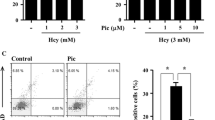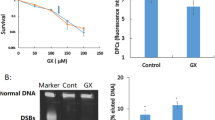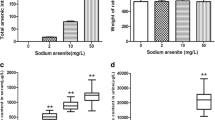Abstract
Chronic arsenic exposure has been linked to endothelial dysfunction and apoptosis. We investigate the involvement of unfolded protein response (UPR) signaling in the arsenic-mediated cytotoxicity of the SVEC4-10 mouse endothelial cells. The SVEC4-10 cells underwent apoptosis in response to As2O3 dose- and time-dependently, accompanied by increased accumulation of calcium, and activation of caspase-3. These phenomena were completely inhibited by α-lipoic acid (LA), which did not scavenge ROS over-production, but were only partially or not ameliorated by tiron, a potent superoxide scavenger. Moreover, arsenic activated UPR, leading to phosphorylation of eukaryotic translation initiation factor 2 subunit α (eIF2α), induction of ATF4, and processing of ATF6. Treatment with arsenic also triggered the expression of endoplasmic reticulum (ER) stress markers, GRP78 (glucose-regulated protein), and CHOP (C/EBP homologous protein). The activation of eIF2α, ATF4 and ATF6 and expression of GRP78 and CHOP are repressed by both LA and tiron, indicating arsenic-induced UPR is mediated through ROS-dependent and ROS-independent pathways. Arsenic also induced ER stress-inducible genes, BAX, PUMA (p53 upregulated modulator of apoptosis), TRB3 (tribbles-related protein 3), and SNAT2 (sodium-dependent neutral amino acid transporter 2). Consistent with intracellular calcium and cell viability data, ROS may not be important in arsenic-induced death, because tiron did not affect the expression of these pro-apoptotic genes. In addition, pretreatment with salubrinal, a selective inhibitor of eIF2α dephosphorylation, enhanced arsenic-induced GRP78 and CHOP expression and partially prevented arsenic cytotoxicity in SVEC4-10 cells. Taken together, these results suggest that arsenic-induced endothelial cytotoxicity is associated with ER stress, which is mediated by ROS-dependent and ROS-independent signaling.






Similar content being viewed by others
References
Allagnat F, Christulia F, Ortis F et al (2010) Sustained production of spliced X-box binding protein 1 (XBP1) induces pancreatic beta cell dysfunction and apoptosis. Diabetologia 53(6):1120–1130. doi:10.1007/s00125-010-1699-7
Baird TD, Wek RC (2012) Eukaryotic initiation factor 2 phosphorylation and translational control in metabolism. Adv Nutr 3(3):307–321. doi:10.3945/an.112.002113
Binet F, Chiasson S, Girard D (2010a) Arsenic trioxide induces endoplasmic reticulum stress-related events in neutrophils. Int Immunopharmacol 10(4):508–512. doi:10.1016/j.intimp.2010.01.013
Binet F, Chiasson S, Girard D (2010b) Evidence that endoplasmic reticulum (ER) stress and caspase-4 activation occur in human neutrophils. Biochem Biophys Res Commun 391(1):18–23. doi:10.1016/j.bbrc.2009.10.141
Binet F, Chiasson S, Girard D (2011) Interaction between arsenic trioxide (ATO) and human neutrophils. Hum Exp Toxicol 30(5):416–424. doi:10.1177/0960327110372645
Bolt AM, Zhao F, Pacheco S, Klimecki WT (2012) Arsenite-induced autophagy is associated with proteotoxicity in human lymphoblastoid cells. Toxicol Appl Pharmacol 264(2):255–261. doi:10.1016/j.taap.2012.08.006
Bouvier N, Flinois JP, Gilleron J et al (2009) Cyclosporine triggers endoplasmic reticulum stress in endothelial cells: a role for endothelial phenotypic changes and death. Am J Physiol Renal Physiol 296(1):F160–F169. doi:10.1152/ajprenal.90567.2008
Bowers AJ, Scully S, Boylan JF (2003) SKIP3, a novel Drosophila tribbles ortholog, is overexpressed in human tumors and is regulated by hypoxia. Oncogene 22(18):2823–2835. doi:10.1038/sj.onc.1206367
Boyce M, Bryant KF, Jousse C et al (2005) A selective inhibitor of eIF2alpha dephosphorylation protects cells from ER stress. Science 307(5711):935–939. doi:10.1126/science.1101902
Bradford MM (1976) A rapid and sensitive method for the quantitation of microgram quantities of protein utilizing the principle of protein-dye binding. Anal Biochem 72:248–254
Brnjic S, Olofsson MH, Havelka AM, Linder S (2010) Chemical biology suggests a role for calcium signaling in mediating sustained JNK activation during apoptosis. Mol BioSyst 6(5):767–774. doi:10.1039/b920805d
Celik I, Gallicchio L, Boyd K et al (2008) Arsenic in drinking water and lung cancer: a systematic review. Environ Res 108(1):48–55. doi:10.1016/j.envres.2008.04.001
Chou YH, Chao PL, Tsai MJ et al (2008) Arsenite-induced cytotoxicity in dorsal root ganglion explants. Free Radic Biol Med 44(8):1553–1561. doi:10.1016/j.freeradbiomed.2007.12.014
Del Razo LM, Quintanilla-Vega B, Brambila-Colombres E, Calderon-Aranda ES, Manno M, Albores A (2001) Stress proteins induced by arsenic. Toxicol Appl Pharmacol 177(2):132–148. doi:10.1006/taap.2001.9291
Dey S, Baird TD, Zhou D, Palam LR, Spandau DF, Wek RC (2010) Both transcriptional regulation and translational control of ATF4 are central to the integrated stress response. J Biol Chem 285(43):33165–33174. doi:10.1074/jbc.M110.167213
Du K, Herzig S, Kulkarni RN, Montminy M (2003) TRB3: a tribbles homolog that inhibits Akt/PKB activation by insulin in liver. Science 300(5625):1574–1577. doi:10.1126/science.1079817
Flora SJ, Pachauri V (2010) Chelation in metal intoxication. Int J Environ Res Public Health 7(7):2745–88. doi:10.3390/ijerph7072745
Harding HP, Zhang Y, Zeng H et al (2003) An integrated stress response regulates amino acid metabolism and resistance to oxidative stress. Mol Cell 11(3):619–633
Haze K, Yoshida H, Yanagi H, Yura T, Mori K (1999) Mammalian transcription factor ATF6 is synthesized as a transmembrane protein and activated by proteolysis in response to endoplasmic reticulum stress. Mol Biol Cell 10(11):3787–3799
Haze K, Okada T, Yoshida H et al (2001) Identification of the G13 (cAMP-response-element-binding protein-related protein) gene product related to activating transcription factor 6 as a transcriptional activator of the mammalian unfolded protein response. Biochem J 355(Pt 1):19–28
Heifetz A, Keenan RW, Elbein AD (1979) Mechanism of action of tunicamycin on the UDP-GlcNAc:dolichyl-phosphate Glc-NAc-1-phosphate transferase. Biochemistry (Mosc) 18(11):2186–2192
Hetz C (2012) The unfolded protein response: controlling cell fate decisions under ER stress and beyond. Nat Rev Mol Cell Biol 13(2):89–102. doi:10.1038/nrm3270
Hsueh YM, Cheng GS, Wu MM, Yu HS, Kuo TL, Chen CJ (1995) Multiple risk factors associated with arsenic-induced skin cancer: effects of chronic liver disease and malnutritional status. Br J Cancer 71(1):109–114
Jennings P, Limonciel A, Felice L, Leonard MO (2013) An overview of transcriptional regulation in response to toxicological insult. Arch Toxicol 87(1):49–72. doi:10.1007/s00204-012-0919-y
Jiang SJ, Lin TM, Wu HL, Han HS, Shi GY (2002) Decrease of fibrinolytic activity in human endothelial cells by arsenite. Thromb Res 105(1):55–62
Kaufman RJ (1999) Stress signaling from the lumen of the endoplasmic reticulum: coordination of gene transcriptional and translational controls. Genes Dev 13(10):1211–1233
Lai E, Teodoro T, Volchuk A (2007) Endoplasmic reticulum stress: signaling the unfolded protein response. Physiology 22(3):193–201. doi:10.1152/physiol.00050.2006
Lantz RC, Hays AM (2006) Role of oxidative stress in arsenic-induced toxicity. Drug Metab Rev 38(4):791–804. doi:10.1080/03602530600980108
Lee AH, Iwakoshi NN, Glimcher LH (2003) XBP-1 regulates a subset of endoplasmic reticulum resident chaperone genes in the unfolded protein response. Mol Cell Biol 23(21):7448–7459
Li J, Lee B, Lee AS (2006) Endoplasmic reticulum stress-induced apoptosis: multiple pathways and activation of p53-up-regulated modulator of apoptosis (PUMA) and NOXA by p53. J Biol Chem 281(11):7260–7270. doi:10.1074/jbc.M509868200
Li C, Xu J, Li F et al (2011) Unfolded protein response signaling and MAP kinase pathways underlie pathogenesis of arsenic-induced cutaneous inflammation. Cancer Prev Res (Phila) 4(12):2101–2109. doi:10.1158/1940-6207.CAPR-11-0343
Lin AM, Chao PL, Fang SF, Chi CW, Yang CH (2007) Endoplasmic reticulum stress is involved in arsenite-induced oxidative injury in rat brain. Toxicol Appl Pharmacol 224(2):138–146. doi:10.1016/j.taap.2007.06.016
Lu FJ, Shih SR, Liu TM, Shown SH (1990) The effect of fluorescent humic substances existing in the well water of Blackfoot disease endemic areas in Taiwan on prothrombin time and activated partial thromboplastin time in vitro. Thromb Res 57(5):747–753
Lu TH, Su CC, Chen YW et al (2011) Arsenic induces pancreatic beta-cell apoptosis via the oxidative stress-regulated mitochondria-dependent and endoplasmic reticulum stress-triggered signaling pathways. Toxicol Lett 201(1):15–26. doi:10.1016/j.toxlet.2010.11.019
Ma Y, Brewer JW, Diehl JA, Hendershot LM (2002) Two distinct stress signaling pathways converge upon the CHOP promoter during the mammalian unfolded protein response. J Mol Biol 318(5):1351–1365
Mackenzie B, Erickson JD (2004) Sodium-coupled neutral amino acid (system N/A) transporters of the SLC38 gene family. Pflugers Arch 447(5):784–795. doi:10.1007/s00424-003-1117-9
Marciniak SJ, Yun CY, Oyadomari S et al (2004) CHOP induces death by promoting protein synthesis and oxidation in the stressed endoplasmic reticulum. Genes Dev 18(24):3066–3077. doi:10.1101/gad.1250704
Morales AA, Gutman D, Lee KP, Boise LH (2008) BH3-only proteins Noxa, Bmf, and Bim are necessary for arsenic trioxide-induced cell death in myeloma. Blood 111(10):5152–5162. doi:10.1182/blood-2007-10-116889
Morales AA, Gutman D, Cejas PJ, Lee KP, Boise LH (2009) Reactive oxygen species are not required for an arsenic trioxide-induced antioxidant response or apoptosis. J Biol Chem 284(19):12886–12895. doi:10.1074/jbc.M806546200
Morse E, Schroth J, You YH et al (2010) TRB3 is stimulated in diabetic kidneys, regulated by the ER stress marker CHOP, and is a suppressor of podocyte MCP-1. Am J Physiol Renal Physiol 299(5):F965–F972. doi:10.1152/ajprenal.00236.2010
Namba T, Ishihara T, Tanaka K, Hoshino T, Mizushima T (2007) Transcriptional activation of ATF6 by endoplasmic reticulum stressors. Biochem Biophys Res Commun 355(2):543–548. doi:10.1016/j.bbrc.2007.02.004
Naranmandura H, Xu S, Koike S et al (2012) The endoplasmic reticulum is a target organelle for trivalent dimethylarsinic acid (DMAIII)-induced cytotoxicity. Toxicol Appl Pharmacol 260(3):241–249. doi:10.1016/j.taap.2012.02.017
Nordstrom DK (2002) Public health. Worldwide occurrences of arsenic in ground water. Science 296(5576):2143–2145. doi:10.1126/science.1072375
O’Connell KA, Edidin M (1990) A mouse lymphoid endothelial cell line immortalized by simian virus 40 binds lymphocytes and retains functional characteristics of normal endothelial cells. J Immunol 144(2):521–525
Oh RS, Pan WC, Yalcin A et al (2012) Functional RNA interference (RNAi) screen identifies system A neutral amino acid transporter 2 (SNAT2) as a mediator of arsenic-induced endoplasmic reticulum stress. J Biol Chem 287(8):6025–6034. doi:10.1074/jbc.M111.311217
Ohoka N, Yoshii S, Hattori T, Onozaki K, Hayashi H (2005) TRB3, a novel ER stress-inducible gene, is induced via ATF4-CHOP pathway and is involved in cell death. EMBO J 24(6):1243–1255. doi:10.1038/sj.emboj.7600596
Ord D, Ord T (2005) Characterization of human NIPK (TRB3, SKIP3) gene activation in stressful conditions. Biochem Biophys Res Commun 330(1):210–218. doi:10.1016/j.bbrc.2005.02.149
Ord D, Meerits K, Ord T (2007) TRB3 protects cells against the growth inhibitory and cytotoxic effect of ATF4. Exp Cell Res 313(16):3556–3567. doi:10.1016/j.yexcr.2007.07.017
Ord T, Ord D, Koivomagi M, Juhkam K, Ord T (2009) Human TRB3 is upregulated in stressed cells by the induction of translationally efficient mRNA containing a truncated 5′-UTR. Gene 444(1–2):24–32. doi:10.1016/j.gene.2009.06.001
Radosavljevic V, Jakovljevic B (2008) Arsenic and bladder cancer: observations and suggestions. J Environ Health 71(3):40–42
Rasheva V, Domingos P (2009) Cellular responses to endoplasmic reticulum stress and apoptosis. Apoptosis 14(8):996–1007. doi:10.1007/s10495-009-0341-y
Roboz GJ, Dias S, Lam G et al (2000) Arsenic trioxide induces dose- and time-dependent apoptosis of endothelium and may exert an antileukemic effect via inhibition of angiogenesis. Blood 96(4):1525–1530
Rodriguez D, Rojas-Rivera D, Hetz C (2011) Integrating stress signals at the endoplasmic reticulum: the BCL-2 protein family rheostat. Biochim Biophys Acta 1813(4):564–574. doi:10.1016/j.bbamcr.2010.11.012
Rutkowski DT, Kaufman RJ (2004) A trip to the ER: coping with stress. Trends Cell Biol 14(1):20–28
Schroder M, Kaufman RJ (2005) ER stress and the unfolded protein response. Mutat Res 569(1–2):29–63. doi:10.1016/j.mrfmmm.2004.06.056
Shi H, Shi X, Liu KJ (2004) Oxidative mechanism of arsenic toxicity and carcinogenesis. Mol Cell Biochem 255(1-2):67–78
Shin SY, Kim CG, Lim Y, Lee YH (2011) The ETS family transcription factor ELK-1 regulates induction of the cell cycle-regulatory gene p21(Waf1/Cip1) and the BAX gene in sodium arsenite-exposed human keratinocyte HaCaT cells. J Biol Chem 286(30):26860–26872. doi:10.1074/jbc.M110.216721
Simeonova PP, Luster MI (2004) Arsenic and atherosclerosis. Toxicol Appl Pharmacol 198(3):444–449
Spuches AM, Kruszyna HG, Rich AM, Wilcox DE (2005) Thermodynamics of the As(III)-thiol interaction: arsenite and monomethylarsenite complexes with glutathione, dihydrolipoic acid, and other thiol ligands. Inorg Chem 44(8):2964–72. doi:10.1021/ic048694q
Stanhill A, Haynes CM, Zhang Y et al (2006) An arsenite-inducible 19S regulatory particle-associated protein adapts proteasomes to proteotoxicity. Mol Cell 23(6):875–885. doi:10.1016/j.molcel.2006.07.023
Tang CH, Chiu YC, Huang CF, Chen YW, Chen PC (2009) Arsenic induces cell apoptosis in cultured osteoblasts through endoplasmic reticulum stress. Toxicol Appl Pharmacol 241(2):173–181. doi:10.1016/j.taap.2009.08.011
Terai K, Hiramoto Y, Masaki M et al (2005) AMP-activated protein kinase protects cardiomyocytes against hypoxic injury through attenuation of endoplasmic reticulum stress. Mol Cell Biol 25(21):9554–9575. doi:10.1128/MCB.25.21.9554-9575.2005
Thuerauf DJ, Morrison L, Glembotski CC (2004) Opposing roles for ATF6alpha and ATF6beta in endoplasmic reticulum stress response gene induction. J Biol Chem 279(20):21078–21084. doi:10.1074/jbc.M400713200
Todd DJ, Lee AH, Glimcher LH (2008) The endoplasmic reticulum stress response in immunity and autoimmunity. Nat Rev Immunol 8(9):663–674. doi:10.1038/nri2359
Tseng CH (2002) An overview on peripheral vascular disease in blackfoot disease-hyperendemic villages in Taiwan. Angiology 53(5):529–537
Tseng CH (2005) Blackfoot disease and arsenic: a never-ending story. J Environ Sci Health C Environ Carcinog Ecotoxicol Rev 23(1):55–74. doi:10.1081/GNC-200051860
Tseng CH (2008) Cardiovascular disease in arsenic-exposed subjects living in the arseniasis-hyperendemic areas in Taiwan. Atherosclerosis 199(1):12–18. doi:10.1016/j.atherosclerosis.2008.02.013
Tseng CH, Chong CK, Tseng CP, Centeno JA (2007) Blackfoot disease in Taiwan: its link with inorganic arsenic exposure from drinking water. Ambio 36(1):82–84
Vahidnia A, van der Voet GB, de Wolff FA (2007) Arsenic neurotoxicity—a review. Hum Exp Toxicol 26(10):823–832. doi:10.1177/0960327107084539
Wang L, Kou MC, Weng CY, Hu LW, Wang YJ, Wu MJ (2012) Arsenic modulates heme oxygenase-1, interleukin-6, and vascular endothelial growth factor expression in endothelial cells: roles of ROS, NF-kappaB, and MAPK pathways. Arch Toxicol 86(6):879–896. doi:10.1007/s00204-012-0845-z
Wei M, Arnold L, Cano M, Cohen SM (2005) Effects of co-administration of antioxidants and arsenicals on the rat urinary bladder epithelium. Toxicol Sci 83(2):237–245. doi:10.1093/toxsci/kfi033
Yamamoto K, Sato T, Matsui T et al (2007) Transcriptional induction of mammalian ER quality control proteins is mediated by single or combined action of ATF6alpha and XBP1. Dev Cell 13(3):365–376. doi:10.1016/j.devcel.2007.07.018
Yang CY (2006) Does arsenic exposure increase the risk of development of peripheral vascular diseases in humans? J Toxicol Environ Health A 69(19):1797–1804. doi:10.1080/15287390600630237
Yen CC, Ho TJ, Wu CC et al (2011) Inorganic arsenic causes cell apoptosis in mouse cerebrum through an oxidative stress-regulated signaling pathway. Arch Toxicol 85(6):565–575. doi:10.1007/s00204-011-0709-y
Yen YP, Tsai KS, Chen YW, Huang CF, Yang RS, Liu SH (2012) Arsenic induces apoptosis in myoblasts through a reactive oxygen species-induced endoplasmic reticulum stress and mitochondrial dysfunction pathway. Arch Toxicol 86(6):923–933. doi:10.1007/s00204-012-0864-9
Yu HS, Chang KL, Kao YH et al (1998) In vitro cytotoxicity of IgG antibodies on vascular endothelial cells from patients with endemic peripheral vascular disease in Taiwan. Atherosclerosis 137(1):141–147
Zhang K (2010) Integration of ER stress, oxidative stress and the inflammatory response in health and disease. Int J Clin Exp Med 3(1):33–40
Zhang H, Duncan G, Wang L et al (2007) Arsenic trioxide initiates ER stress responses, perturbs calcium signalling and promotes apoptosis in human lens epithelial cells. Exp Eye Res 85(6):825–835. doi:10.1016/j.exer.2007.08.018
Acknowledgments
This study was supported by Grant NSC-99-2320-B-041-005-MY3 (to M.-J. Wu) from National Science Council, Taiwan, ROC.
Author information
Authors and Affiliations
Corresponding authors
Electronic supplementary material
Below is the link to the electronic supplementary material.
Rights and permissions
About this article
Cite this article
Weng, CY., Chiou, SY., Wang, L. et al. Arsenic trioxide induces unfolded protein response in vascular endothelial cells. Arch Toxicol 88, 213–226 (2014). https://doi.org/10.1007/s00204-013-1101-x
Received:
Accepted:
Published:
Issue Date:
DOI: https://doi.org/10.1007/s00204-013-1101-x




